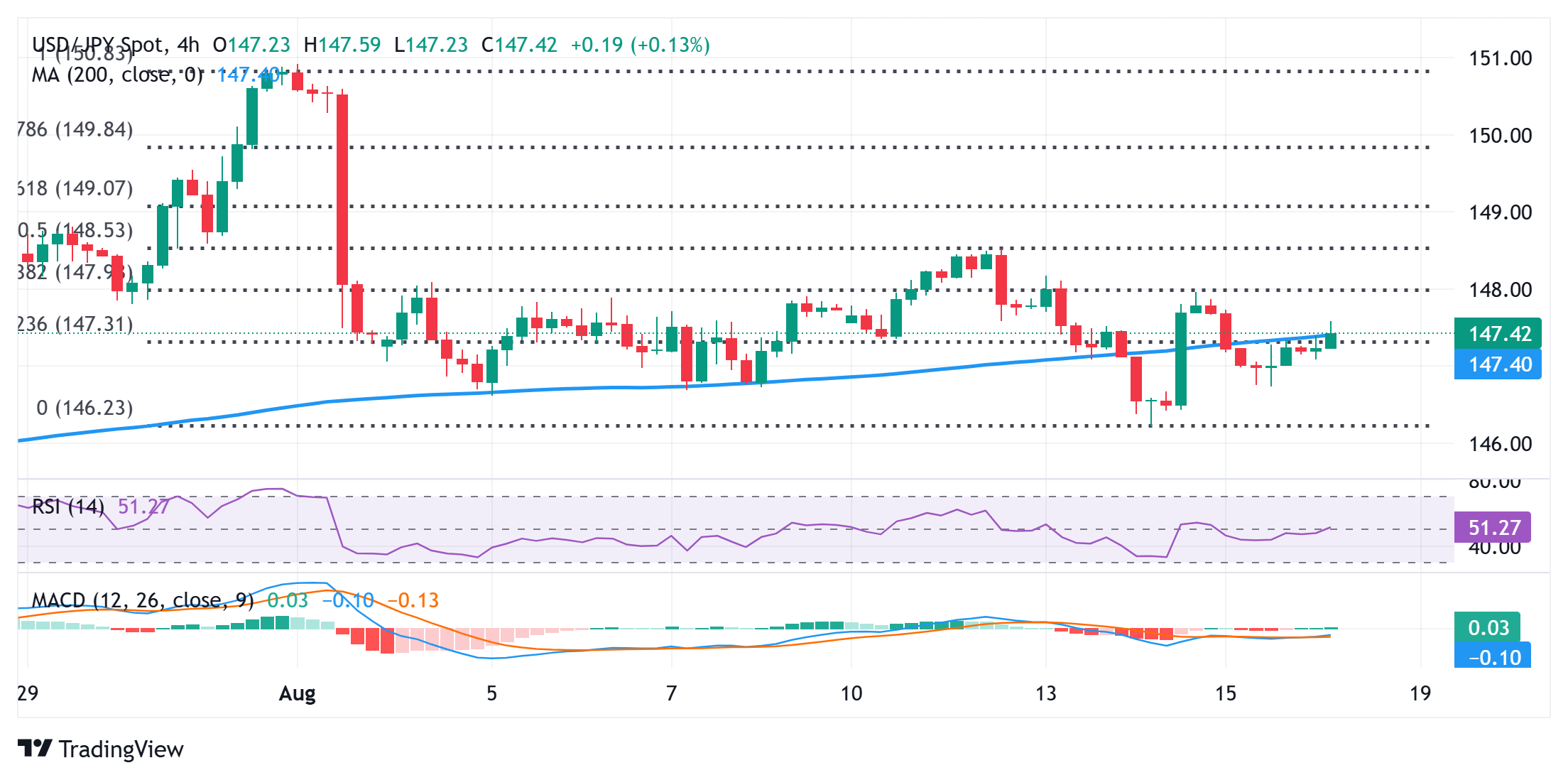Japanese Yen drifts lower amid reduced safe-haven demand, BoJ rate hike uncertainty

- The Japanese Yen drifts lower amid receding safe-haven demand and BoJ rate hike uncertainty.
- Reduced bets for a jumbo Fed rate cut in September support the USD and the USD/JPY pair.
- The divergent BoJ-Fed policy expectations warrant caution before placing aggressive bullish bets.
The Japanese Yen (JPY) kicks off the new week on a weaker note amid a combination of factors, which, along with a modest US Dollar (USD) uptick, lifts the USD/JPY pair to mid-147.00s during the Asian session. The uncertainty over the likely timing of the next interest rate hike by the Bank of Japan (BoJ), along with the prevalent risk-on environment, is seen undermining the safe-haven JPY. However, firming expectations that the BoJ will stick to its policy normalization path might hold back the JPY bears from placing aggressive bets.
Meanwhile, a relatively hawkish BoJ marks a significant divergence in comparison to other major central banks, including the Federal Reserve (Fed), which is anticipated to resume its rate-cutting cycle in September. This could act as a headwind for the USD and benefit the lower-yielding JPY, warranting some caution before positioning for any further appreciating move for the USD/JPY pair. Traders might also opt to move to the sidelines ahead of Fed Chair Jerome Powell's speech at the Jackson Hole Symposium later this week.
Japanese Yen is undermined by hopes for an end to the Russia-Ukraine war
- The high-stakes meeting between US President Donald Trump and Russian leader Vladimir Putin in Alaska yielded no clear breakthrough. Investors, however, remain hopeful that the dialogue has increased the chances of ending the prolonged war in Ukraine.
- Trump said early Monday that Ukrainian President Volodymyr Zelenskiy can end the war with Russia almost immediately if he wants to. Trump and Zelenskiy will have a bilateral meeting prior to the European leaders joining a larger conversation later today.
- The development helps ease geopolitical risks and remains supportive of the prevalent risk-on environment. This, in turn, prompts some selling around the safe-haven Japanese Yen during the Asian session on Monday amid the Bank of Japan rate-hike uncertainty.
- Domestic political uncertainty following the ruling Liberal Democratic Party’s loss in the upper house election, along with concern about the negative economic impact of higher US tariffs, suggests that the prospects for further BoJ policy normalization could be delayed.
- Meanwhile, data released on Friday showed that Japan's economy expanded more than expected in the second quarter despite US tariff headwinds. This, along with an upward revision of the BoJ's inflation forecast, keeps the door open for a rate hike by the year-end.
- In contrast, market participants are pricing in about 85% chances that the Federal Reserve will lower borrowing costs at the next policy meeting in September. Moreover, the US central bank is expected to deliver at least two 25-basis-point interest rate cuts in 2025.
- On the economic data front, the US Census Bureau reported on Friday that the US Retail Sales increased by 0.5% on a monthly basis in July. This followed the 0.9% increase (revised up from 0.6%) recorded in June and came in line with the market expectation.
- However, the preliminary data from the University of Michigan showed that the US Consumer Sentiment Index unexpectedly dropped to 58.6 from 61.7 in July, signalling a poor backdrop in public confidence. Moreover, the Expectations Index eased to 57.2 from 57.7.
- However, the one-year inflation expectations climbed to 4.9% from 4.5% and the five-year forecast increased to 3.9% from 3.4%. This comes on top of the strong US Producer Price Index released last Thursday and points to some gain of momentum in price pressures.
- This, in turn, further tempers bets for a more aggressive policy easing by the Fed and bets for a jumbo rate cut in September, which offers some support to the US Dollar and the USD/JPY pair. The lack of any meaningful buying, however, warrants caution for bulls.
- Traders might also refrain from placing aggressive directional bets and opt to wait for the release of the FOMC meeting minutes on Wednesday. Apart from this, Fed Chair Jerome Powell's speech at the Jackson Hole Symposium is expected to provide rate-cut cues and some meaningful impetus.
USD/JPY is likely to confront a stiff hurdle and remain capped near the 148.00 mark

The USD/JPY pair has been oscillating in a familiar range over the past two weeks or so. This points to a consolidation phase and makes it prudent to wait for an eventual break on either side before positioning for the next leg of a directional move amid neutral technical indicators on the daily chart.
Meanwhile, an intraday rise beyond the 23.6% Fibonacci retracement level of the downfall from the monthly swing high backs the case for additional gains. Any further move up beyond the 200-period Simple Moving Average (SMA) on the 4-hour chart, however, is likely to confront stiff resistance near the 148.00 mark, or the 38.2% Fibo. retracement level.
A sustained strength and acceptance above the said handle might shift the near-term bias in favor of bulls. The USD/JPY pair might then climb to the 148.55-148.60 region, or the 50% retracement level, and extend the positive momentum further towards the 149.00 round figure.
On the flip side, the 147.10-147.00 area could offer immediate support, below which the USD/JPY pair could retest the multi-week low, around the 146.20 zone, touched last Thursday, Some follow-through selling, leading to a subsequent fall below the 146.00 round figure, will be seen as a fresh trigger for bearish traders and make spot prices vulnerable to extend the fall to the the 145.40-145.30 region en route to the 145.00 psychological mark.
Japanese Yen FAQs
The Japanese Yen (JPY) is one of the world’s most traded currencies. Its value is broadly determined by the performance of the Japanese economy, but more specifically by the Bank of Japan’s policy, the differential between Japanese and US bond yields, or risk sentiment among traders, among other factors.
One of the Bank of Japan’s mandates is currency control, so its moves are key for the Yen. The BoJ has directly intervened in currency markets sometimes, generally to lower the value of the Yen, although it refrains from doing it often due to political concerns of its main trading partners. The BoJ ultra-loose monetary policy between 2013 and 2024 caused the Yen to depreciate against its main currency peers due to an increasing policy divergence between the Bank of Japan and other main central banks. More recently, the gradually unwinding of this ultra-loose policy has given some support to the Yen.
Over the last decade, the BoJ’s stance of sticking to ultra-loose monetary policy has led to a widening policy divergence with other central banks, particularly with the US Federal Reserve. This supported a widening of the differential between the 10-year US and Japanese bonds, which favored the US Dollar against the Japanese Yen. The BoJ decision in 2024 to gradually abandon the ultra-loose policy, coupled with interest-rate cuts in other major central banks, is narrowing this differential.
The Japanese Yen is often seen as a safe-haven investment. This means that in times of market stress, investors are more likely to put their money in the Japanese currency due to its supposed reliability and stability. Turbulent times are likely to strengthen the Yen’s value against other currencies seen as more risky to invest in.






